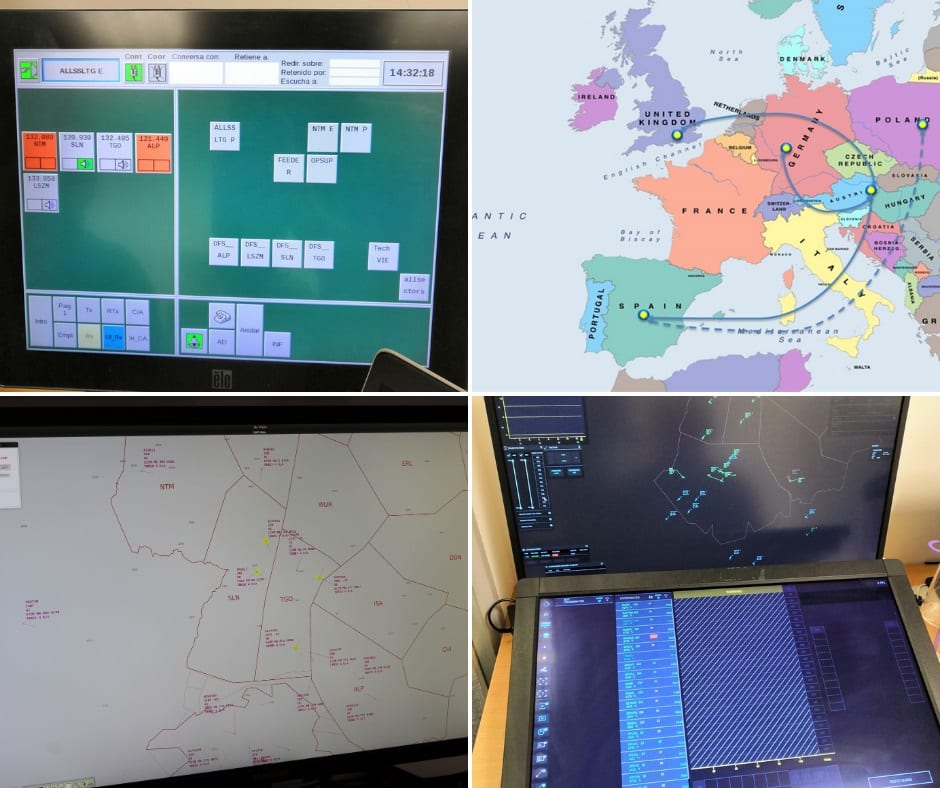SESAR Trial Validates Virtual Air Traffic Management of Flights in Three European Countries


A trial conducted under the Single European Sky ATM Research (SESAR) 2020 project PJ.10-W2 PROSA, used controller working position screens at the three different European locations with real time simulation. (SESAR)
Air traffic controllers in Germany, Poland, and the U.K. recently validated the feasibility of the use of a virtual center to manage flights in the cross-border style that many Air Navigation Service Providers (ANSPs) in the region see as the key to streamlining the current segmented structure present in Europe.
Validation of the concept was completed under the Single European Sky ATM Research (SESAR) 2020 project PJ.10-W2 PROSA, one of the largest research initiatives included in their 2020 industrial research program. According to a March 5 press release announcing the completion of the trial, Physical centers were located in Langen (Germany), Southampton (U.K.), and Warsaw (Poland), with two test cases.
The first case trialed the transfer of consolidated traffic from one control center to another at night; the second simulated the transfer of air traffic control services to another center in a failure scenario, according to the ANSPs involved in the project.
Representatives from DFS, ENAV, Frequentis, Indra, NATS and Polish Air Navigation Services Agency (PANSA) provided joint responses to questions from Avionics International about the near term feasibility of the concept, confirming that the trial did not use real flights, but rather a simulation that featured recorded radar and flight plan data. This data was fed into the prototype digital ATM infrastructure they developed using a real-time simulator and technologies submitted by some of the individual service providers.
“Until such a concept may finally be used between one country’s service units or even among European ANSPs, it will still be a long path. Such operations are not just a question of the sovereignty of the different States, which until now are responsible for their own airspaces, and thus legal considerations, but also a question of the licensing of air traffic controllers,” a representative for the group said in an emailed statement.
During the trial, PANSA controllers in Warsaw controlled, grouped, or consolidated sectors and delegated them to controllers from NATS in Southampton, who were able to delegate on to DFS in Langen.

The Polish Air Navigation Services Agency (PANSA) signed an agreement with Indra, to implement the iTEC system in the new Control Center in Poznan. Indra also used the iTEC system in the SESAR PROSA virtual center trial.
Europe’s current air traffic system features decision-making based solely on the individual air navigation service providers in each European nation-state, where data is made available based on the decisions of the individual ANSPs and where needed, ANSPs are given very little control over adjacent airspace to the flight information region (FIR) that they’re responsible for.
Under the vision for virtual centers, the currently fragmented structure would be decoupled and transitioned to the development of a new data servicing system where individual Air Traffic Service Units (ATSUs) work in tandem with ATM Data Service Providers (ADSPs) that provide flight data processing functions like flight correlation, trajectory prediction, conflict detection and resolution, and arrival management planning.
“During the scenario for nighttime delegation, we have trialed between 30 to 50 flights. In the scenario for contingency delegation, around 100 flights were validated. The scenarios took place in a defined part of the airspace – comprising two sectors of Karlsruhe upper airspace over southern Germany, as well as in Zurich airspace,” the representative said.
Through the project, the service providers were also able to observe the technological comments of establishing a virtual center with data centers deployed in different locations. Using their iTEC ATM system, Indra provided recorded radar and flight plan data using a real-time simulator and equipped the controller working positions in the UK and Poland with the components for voice communication.
Frequentis also supplied the digital medium for distributing and sharing data across the entire setup, according to the group.
“The components included a pseudo pilot position and Ground-Ground voice communication telephony system with touch screen HMI user interface panels at the working positions. The solution was implemented by using the ED-137 Interoperability Standard – Voice Over Internet Protocol (VoIP) and converged IP networks,” the representative said. “The supplied middleware makes use of an open ATM-grade IT platform supplied by Frequentis, extended with ATS Message Handling System AMHS P3 and Aeronautical Fixed Telecommunication Network (AFTN) gateway functions.”
As the first trial executed within SESAR’s PROSA project, the validation was one of several that will be completed as part of the same research initiative. Automatic speech recognition, attention guidance, and increased flexibility in air traffic controller validations are among the other separation management tools that are being trialed.
The post SESAR Trial Validates Virtual Air Traffic Management of Flights in Three European Countries appeared first on Aviation Today.
Check FastApn access for commercial satcoms at Fastapn
Flytlink – Avionics, Satcom’s and IFE Consultants






